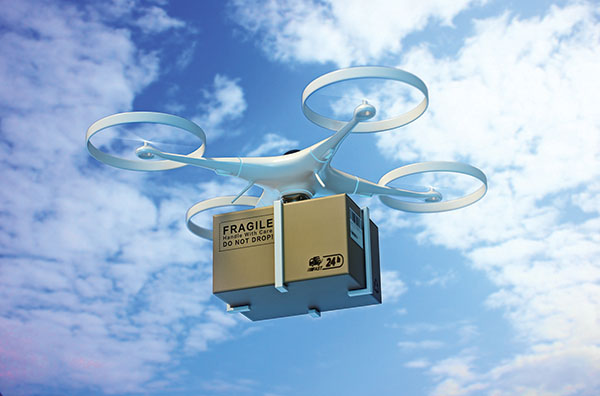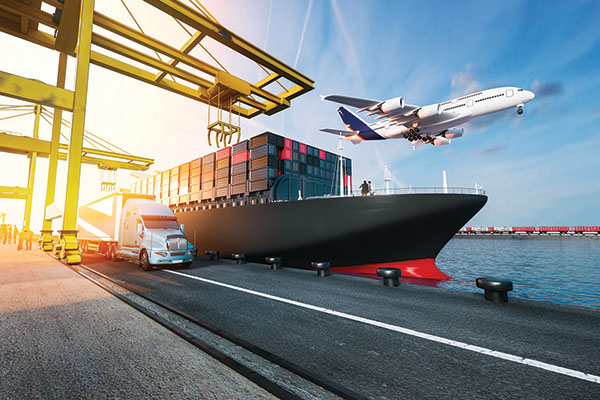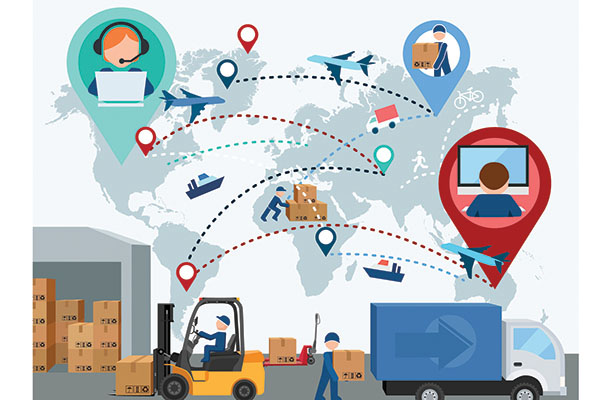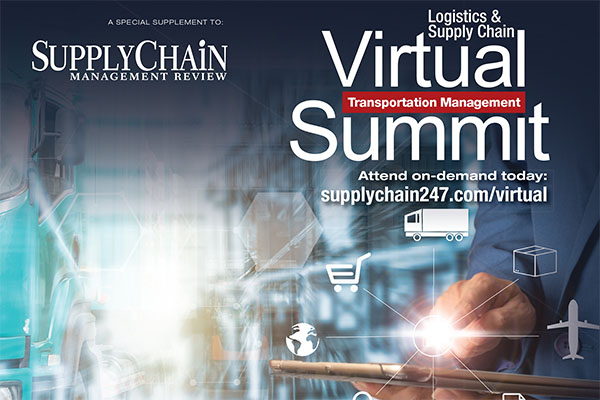2018 Logistics and Supply Chain Virtual Summit Roundup: Navigating the new reality
Our latest Virtual Summit tackles the most serious transportation issues facing shippers and explains what companies can do to operate smarter and more efficiently in the tightest freight environment in more than a generation. You can attend on-demand today at supplychain247.com/virtual
The national economy is booming, e-commerce sales are going through the roof, and shippers across all industries are busier than ever. While all positive of course, these factors have converged to create a challenging transportation, fulfillment and labor environment for logistics and supply chain organizations. Today, nearly all U.S. shippers are grappling with rising freight bills, a dearth of skilled labor, driver shortages, new federal regulations and capacity crunches.
To help shippers tackle these pressing issues, Logistics Management and Supply Chain Management Review assembled an expert line-up of analysts and thought leaders for this year’s Virtual Summit. Focused on transportation management, the event offers new concepts and solutions for creating connected, streamlined operations that enable flexibility while also sharing new levels of transportation management excellence.
Here’s a quick synopsis this year’s Virtual Summit
2018 Keynote
The New Transportation Management Realities

When you’re running a supply chain or logistics operation, putting out daily—or even hourly—fires can consume most of your time. This leaves little opportunity to put the current state of freight transportation into perspective, assess the market drivers that are moving that market and predict what’s coming around the next corner.
In his Virtual Summit Keynote, Nick Vyas, executive director of USC’s Center for Global Supply Chain Management, addresses all of these key points while also offering practical advice that shippers can use to improve their own logistics approaches.
Vyas takes participants through globalization, technology’s impact on transportation management, and ends with the current trends and realities in transportation. He kicks off his keynote by discussing how the growing consumer class and the growth of mega cities are working together to drive globalization.
“These factors will all contribute to the future transportation network,” says Vyas. “Every region is growing at a different pace, and Asia is growing the fastest with the largest population growth rate.” At the same time, the consumer is evolving and buying more via e-commerce, and these trends are changing the middle mile- and last-mile delivery strategy. “Speed and transparency are no longer value adds,” says Vyas, “it’s now a requirement.”
Vyas also talks about the influx of disruptive technology in the transportation sector, noting that technology that used to take decades or even centuries to develop is now being discovered and commercialized within a year. “Disruptive technology will continue to evolve,” Vyas says, “and we really have to embrace it and be ready for it.”
Session 1
2018 Logistics and Transportation Trends Survey: Will new tools fix our old problems?

Today’s shippers are assessing new technologies to better manage and streamline operations, but the results of Logistics Management’s “27th Annual Study on Trends and Issues in Logistics & Transportation Survey” suggest that these new tools alone will not solve the age-old problems that logistics and supply chain professionals are still facing.
For example, companies across all industries are struggling to find the capacity they need while managing escalating costs. In their Virtual Summit session, professors Mary C. Holcomb, Ph.D., and Karl B. Manrodt, Ph.D., discuss the survey, which included 240 respondents across 15 industry sectors.
In assessing which technologies will have the most impact on logistics over the next two years, Holcomb says that many shippers will be focused on analytics. “Predictive analytics is really going to extend beyond the reports,” Holcomb points out. “We are going to be using statistical methods and perhaps machine learning techniques to really identify the likelihood of future outcomes and we’re going to use that historical data to get there.”
And if companies can get information faster, Holcomb points out, they’ll be able to improve service performance and leverage the digital supply chain data and information to increase supply chain capabilities.
The speakers also discussed where investments are being made in the digital space, what barriers are keeping companies from going digital, and why digital transformation is important. “When it comes to digitalization in transportation, some people are on their way and others will be left in the dust,” says Manrodt. “It’s a journey and a process, and people will get left behind if they are laggards.”
Session 2
Reinventing Transportation Management: A call to action

The North American freight procurement process hasn’t evolved much over the last two decades, with many shippers and carriers using the same methods, technologies, and contractual arrangements that they used back in the 1990s. That’s about to change, thanks to the advent of new technologies, increased data fluency, and the digitization of more transportation-related processes.
In this session, Chris Caplice, MIT Center for Transportation & Logistics’ executive director, delves into the current state of transportation procurement and how “dominant design” is being challenged by the rise of new technologies, availability of detailed data, and the adoption of advanced methodologies.
In order to understand the future of transportation management, Caplice discusses how freight transportation is procured today, what dominant design is (and why we should care about it), and puts out a call to action for third-party logistics (3PL) providers, shippers and carriers.
“A lot of things are changing, and those changes aren’t just due to the capacity crisis of the last 18 months,” Caplice points out. “Markets, information, and the appetite of both shippers and carriers to manage uncertainty are all changing. For example, running an auction to find the market rate doesn’t make sense anymore.”
According to Caplice, there’s no longer a “one-size-fits-all” transportation or freight solution that works for every organization. “Today, there’s a totally new portfolio of options out there that shippers need to consider,” Caplice says. “Because of this, transportation management isn’t as simple as it was a couple of decades ago.”
Session 3
Harnessing e-fulfillment and final-mile management

As companies race to come up with the best approaches to e-fulfillment and last-mile delivery, the growth of residential in-home deliveries continues to go through the roof. With companies now expected to deliver packages containing a single item as small as a tube of Chapstick within a day or two (or sometimes less), the pressure on the fulfillment process isn’t going to let up anytime soon.
In this Virtual Summit session, Victoria Brown, IDC Manufacturing Insights’ research manager, Global Supply Chain Execution, discusses the key change drivers that all shippers are dealing with and delves into the strategic supply chain priorities, digital transformation, future supply chain investments, and the steps organizations and shippers should be taking now.
Throughout her presentation, Brown highlights a recent IDC survey focused on key supply chain pain points and drivers. Thanks to the e-commerce boom, for example, companies have to become more efficient with “re-commerce,” Brown says, when goods come back to the warehouse and must be redirected to a new consumer or other source.
“The reality is that we need to be thinking about fulfillment as an enabler,” Brown points out. “The more we do to balance fulfillment and it’s relationship with last-mile delivery, the better our business outcomes will be and the happier our customers will be.”
Session 4
State of Brokerage: Putting innovation to work

For trucking companies, market conditions just may be the best that they’ve ever been. What’s more, the truckload brokerage market continues to see rapid gains in technology adoption, putting it squarely on a smooth road to profitability while also reaping the benefits of current market conditions.
But how long can these good times last for brokers and the overall trucking market? In this Virtual Summit session, Robert W. Baird & Co. senior research analyst Ben Hartford offers shippers a deep dive into the dynamic freight brokerage market; discusses the factors driving the sector’s rapid growth; and shares insight into the massive investment and technological innovations driving this sector forward.
Hartford takes the audience through a journey of the past, present and future of freight brokerage, noting that the capacity crunch and supply constraints are two major trends in the freight industry right now. “The year 2018 was one for the record books,” says Hartford, “with events like the 2017 hurricane activity and the electronic logging device (ELD) implementation drastically shaping supply and demand.”
Hartford also discusses the continued evolution of “Logistics 2.0,” and points to supply chain visibility and automation as its two most important characteristics. He also discusses emerging themes and potential models for the future of freight. “The opportunity is there for both brokers and carriers,” Hartford says. “It just comes down to a question of who chooses to be proactive and innovate.”
Session 5
Leveraging TMS: Simplify growing complexity

Acritical link in the supply chain, transportation is costly, time-consuming and sometimes difficult to manage. It’s not going to get any easier as trucking capacity tightens and as rates continue to rise in 2019. Done right, however, transportation management can help shippers create efficiencies, improve productivity, save money and provide premium levels of customer service.
Bob Hood, Capgemini’s principal analyst and lead of its Move Domain practice, puts the state of the transportation management systems (TMS) market into perspective, examines current adoption trends, and shares the evolution of TMS functionality and delivery methods. Hood also shows shippers how to fully leverage the power of these solutions to help gain the capacity they need (and at the price that won’t break the bank).
Hood kicks off this Virtual Summit session by discussing top transportation challenges, including cost, flexibility, and speed. “These are the three factors that are inhibiting transportation today,” says Hood. “We’re in an environment today where client expectations continue to grow. With the Amazon effect, the expectation of immediate gratification in terms of being able to place an order and have your product be delivered, if not in two days, in many cases in the same day.”
That expectation is putting tremendous pressure on shippers to provide flawless product delivery, and on an accelerated basis. Hood sees the modern-day TMS as the right tool for overcoming this and other transportation-related problems. “TMS solutions have evolved over the years,” says Hood, “and continue to get more capable in terms of what they deliver, from a feature and function perspective.”
We would like to give a special thank you to our sponsors:














